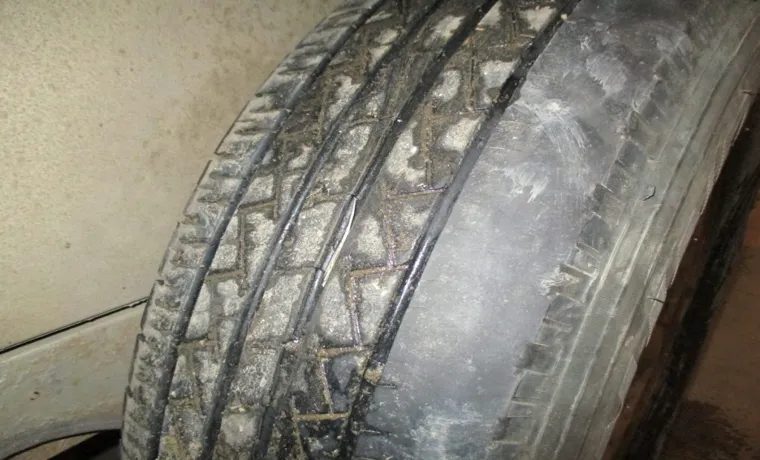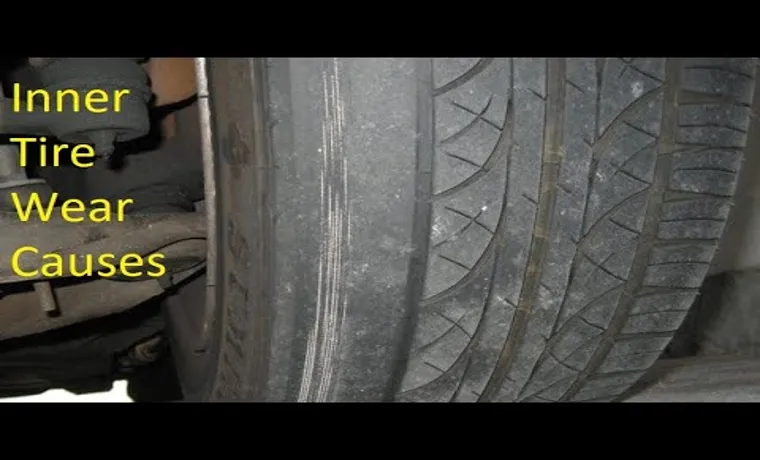Have you ever noticed that your tires tend to wear out more on the inside than on the outside? If so, you’re not alone. Many drivers wonder why their tires wear unevenly, and it can be a frustrating and expensive problem to deal with. Fortunately, there are some common reasons why tires wear on the inside, and there are also steps you can take to prevent this from happening in the future.
In this blog post, we’ll explore the various factors that contribute to inside tire wear, including alignment issues, tires that are underinflated, poor driving habits, and more. We’ll also provide you with some tips and tricks for keeping your tires in top condition, so you can avoid costly repairs and replacements down the road. So, if you’re ready to learn more about why your tires wear on the inside, read on!
Table of Contents
Incorrect Alignment
If you notice that your tire is wearing on the inside, it could be due to incorrect alignment. When your vehicle is not aligned correctly, it can cause the tires to wear unevenly. This can result in the inner part of the tire wearing faster than the outer part.
The camber angle, which refers to the angle of the wheels from the front to the back of the vehicle, can also cause tire wear if it is not set correctly. If the camber angle is too negative, meaning the top of the tire is tilted inward, it can cause the inside of the tire to wear more quickly. It is important to get your vehicle’s alignment checked regularly to prevent excessive tire wear and to avoid unsafe driving conditions.
Toe-In Alignment
Incorrect alignment of a vehicle’s wheels can lead to a number of problems, including uneven tire wear, decreased fuel efficiency, and difficulty steering the vehicle. One common type of alignment issue is known as toe-in alignment, which occurs when the wheels of a vehicle are angled inward towards each other rather than being perfectly straight. This misalignment can result in a vehicle that pulls to one side or the other while driving, and can also cause a sensation of instability or wobbling while moving at high speeds.
While toe-in alignment can be caused by a number of factors, including worn suspension components, it is typically corrected through the use of alignment tools and adjustments made by a qualified mechanic. By addressing alignment issues early and regularly, drivers can avoid more serious problems down the road and keep their vehicles running smoothly and efficiently for years to come.

Toe-Out Alignment
If you’re experiencing uneven tire wear, pulling to one side, or an off-center steering wheel, it could be due to incorrect alignment. One common type of misalignment is toe-out alignment, which occurs when the wheels are pointed outward instead of straight ahead. This can be caused by worn steering parts, damage to the suspension, or an impact on the wheel.
If left unaddressed, toe-out alignment can cause excessive tire wear and affect the vehicle’s handling and stability. It’s important to have your alignment checked regularly by a professional and address any issues promptly. Don’t let toe-out alignment put a damper on your driving experience, get it fixed before it causes further damage.
Camber Misalignment
Camber misalignment is a common issue that occurs when your wheels are not perpendicular to the ground. This can happen due to various reasons like worn-out suspension parts, improper wheel balancing, or even poor road conditions. When the camber is misaligned, the top of the tire either leans outward or inward, which can affect your vehicle’s handling and tire wear.
Your vehicle may pull to one side, and you might experience uneven tire wear. This misalignment can also cause steering and suspension problems, leading to a bumpy ride. Ensure that you get your alignment checked regularly to avoid such issues.
Remember, even the slightest misalignment can impact your driving experience.
Improper Tire Pressure
If your tire wears on the inside, the culprit could be improper tire pressure. Overinflated or underinflated tires can lead to uneven wear, with the inside of the tire wearing out faster than the rest of the tread. This can also affect the handling and stability of your vehicle, making it more difficult to control on the road.
It’s important to check your tire pressure regularly and make sure they are filled to the manufacturer’s recommended levels. Not only will this prevent uneven wear, but it can also improve your vehicle’s fuel efficiency and extend the life of your tires. Don’t let improper tire pressure cause unnecessary wear and tear on your tires – make sure you’re keeping them properly inflated.
Over-Inflated Tires
Over-Inflated Tires Proper tire pressure is crucial for maintaining the safety of your vehicle. Over-inflated tires can lead to a bumpy and uncomfortable ride, and more seriously, can cause tires to fail unexpectedly. When tires are over-inflated, the center of the tire bears most of the vehicle’s weight, which causes uneven tread wear and reduces the tire’s overall lifespan.
Additionally, over-inflated tires have a smaller contact patch with the road, reducing their ability to grip the pavement and increasing the risk of hydroplaning in wet weather. That’s why it’s important to regularly check your tire pressure and adjust it to the manufacturer’s recommended levels. This will not only make your ride smoother and safer but can also improve your vehicle’s fuel efficiency and save you money in the long run.
So, make sure to keep your tires properly inflated and hit the road with confidence.
Under-Inflated Tires
Under-Inflated Tires can be a major issue for any driver. Improper tire pressure can lead to decreased fuel efficiency, reduced traction on the road, and even cause your tires to wear out more quickly. That’s why it’s important to check your tire pressure regularly and ensure that it’s at the recommended level.
Not only will proper tire inflation help improve your driving experience, but it can also prolong the life of your tires and prevent unnecessary headaches down the road. So, the next time you’re getting ready to hit the road, take a few minutes to check your tire pressure. You’ll be glad you did!
Worn Suspension Components
If you notice your tire wearing out on the inside, it could be an indication of worn suspension components. When the suspension components of your vehicle are worn out, they can cause the tires to lean inwards or outwards, which subsequently leads to uneven tire wear. Additionally, if your vehicle’s suspension is sagging, it could cause the tires to wear out on the inside.
Poor alignment and over-inflation could also lead to this issue. To prevent uneven tire wear, it’s important to have your vehicle inspected regularly by a professional mechanic who can check for any worn components that could affect your tire’s lifespan. Furthermore, maintaining proper tire pressure and alignment can help extend the life of your tires and prevent the need for premature replacement.
Worn Ball Joints
Worn Ball Joints As crucial components of your vehicle’s suspension system, ball joints play a pivotal role in maintaining a smooth and comfortable ride. Over time, however, these joints can wear out due to general wear and tear, rough roads, and aggressive driving. When they do wear out, you might experience a range of issues including vibrations, uneven tire wear, and poor handling.
It’s essential to catch and address worn ball joints early before they become a safety hazard. Regular suspension inspection and maintenance can help you identify and replace faulty ball joints, ultimately ensuring better handling, less wear on tires, and a safer driving experience. So, if you notice any signs of worn ball joints, like a knocking noise when turning, don’t delay in getting it taken care of.
Your vehicle and your safety are too important to risk.
Worn Control Arm Bushings
If you’re noticing some odd sounds or vibrations when you’re driving, it could be due to worn suspension components. One possible culprit is worn control arm bushings. These bushings help to keep your car’s suspension connected to the frame of the car.
Over time, these bushings can wear down and start to crack, causing a number of issues. You might notice more sway or roll when you’re turning, or your car’s steering might feel less responsive. If you leave the problem unchecked, your tires could start to wear unevenly, decreasing your car’s handling.
It’s important to get your car to the mechanic if you suspect you have worn control arm bushings, as they can quickly become a serious safety issue. By replacing these worn bushings, you can help restore your car’s suspension and handling.
Driving Habits and Conditions
Tire wear on one side is not uncommon, and it’s usually caused by a few factors. One of the primary reasons for inside tire wear is driving habits and road conditions. Typically, aggressive cornering, hard braking, and high-speed driving on uneven or bumpy roads are the most typical causes of uneven tire wear.
These driving habits result in more force and pressure being applied to the inner part of the tires, causing them to wear out more quickly than the rest of the tire. A lack of regular tire rotation and incorrect tire alignment can also lead to uneven tire wear over time. In all cases, regular maintenance and corrective measures are essential for preventing excess wear on tires and ensuring that they last as long as possible.
It’s always a good idea to have regular tire checkups and take care of any tire-related issues as soon as they arise. By doing so, you’ll save yourself a lot of money in repair costs and keep your vehicle running smoothly for years to come.
Conclusion
In the end, it’s all about balance – just like in life. If your vehicle’s alignment is not properly maintained and the weight distribution is off, it’s only a matter of time before your tire wears on the inside. So, if you want your ride to be smooth and your tires to last, make sure everything is in proper alignment – in your car and in your day-to-day activities.
“
FAQs
What are the common causes of tires wearing on the inside?
Some of the common causes of tires wearing on the inside include misalignment, improper tire pressure, and worn-out suspension components.
Can overinflation lead to tire wear on the inside?
Yes, overinflation can increase the wear on the middle part of the tire, leading to tire wear on the inside.
What type of suspension issues can cause tires to wear on the inside?
Suspension issues like worn-out shocks, ball joints, and tie rods can cause tires to wear on the inside.
Can driving on rough roads cause tires to wear on the inside?
Yes, driving on rough roads can cause misalignment, which can lead to tire wear on the inside.
Is it possible for tire tread to wear evenly but still have tire wear on the inside?
Yes, it is possible due to misalignment issues that can cause even tire tread wear but excessive wear on the inside.
How often should I have my alignment checked to prevent tire wear on the inside?
It is recommended to have your alignment checked every 6 months or 6,000 miles to prevent tire wear on the inside.
Can rotating my tires help prevent tire wear on the inside?
Yes, rotating your tires regularly can help ensure even wear and prevent excessive wear on the inside of the tires.


